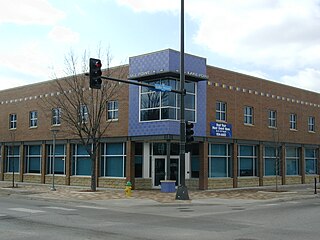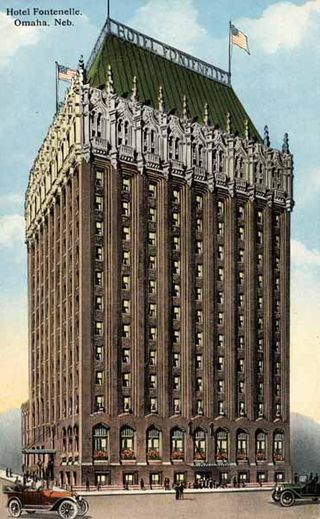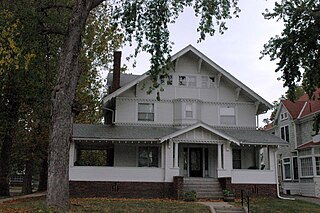Related Research Articles

North Omaha is a community area in Omaha, Nebraska, in the United States. It is bordered by Cuming and Dodge Streets on the south, Interstate 680 on the north, North 72nd Street on the west and the Missouri River and Carter Lake, Iowa on the east, as defined by the University of Nebraska at Omaha and the Omaha Chamber of Commerce.
North Omaha, Nebraska has a recorded history spanning over 200 years, pre-dating the rest of Omaha, encompassing wildcat banks, ethnic enclaves, race riots and social change. North Omaha has roots back to 1812 and the founding of Fort Lisa. It includes the Mormon settlement of Cutler's Park and Winter Quarters in 1846, a lynching before the turn of the twentieth century, the thriving 24th Street community of the 1920s, the bustling development of its African-American community through the 1950s, a series of riots in the 1960s, and redevelopment in the late 20th and early 21st century.
Saratoga Springs, Nebraska Territory, or Saratoga, was a boom and bust town founded in 1856 that thrived for several years. During its short period of influence the town grew quickly, outpacing other local settlements in the area including Omaha and Florence, and briefly considered as a candidate for the Nebraska Territorial capitol. Saratoga was annexed into Omaha in 1887, and has been regarded a neighborhood in North Omaha since then.

The history of Omaha, Nebraska, began before the settlement of the city, with speculators from neighboring Council Bluffs, Iowa staking land across the Missouri River illegally as early as the 1840s. When it was legal to claim land in Indian Country, William D. Brown was operating the Lone Tree Ferry to bring settlers from Council Bluffs to Omaha. A treaty with the Omaha Tribe allowed the creation of the Nebraska Territory, and Omaha City was founded on July 4, 1854. With early settlement came claim jumpers and squatters, and the formation of a vigilante law group called the Omaha Claim Club, which was one of many claim clubs across the Midwest. During this period many of the city's founding fathers received lots in Scriptown, which was made possible by the actions of the Omaha Claim Club. The club's violent actions were challenged successfully in a case ultimately decided by the U.S. Supreme Court, Baker v. Morton, which led to the end of the organization.
Education in Omaha, Nebraska is provided by many private and public institutions. The first high school graduates in the Omaha area came from Brownell-Talbot School, which was founded in the town of Saratoga in 1863. The oldest school building in continuous usage is Omaha Central High School.
The neighborhoods of Omaha are a diverse collection of community areas and specific enclaves. They are spread throughout the Omaha metro area, and are all on the Nebraska side of the Missouri River.

Culture in North Omaha, Nebraska, the north end of Omaha, is defined by socioeconomic, racial, ethnic and political diversity among its residents. The neighborhood's culture is largely influenced by its predominantly African American community.
The Near North Side of Omaha, Nebraska is the neighborhood immediately north of downtown. It forms the nucleus of the city's historic African-American community, and its name is often synonymous with the entire North Omaha area. Originally established immediately after Omaha was founded in 1854, the Near North Side was once confined to the area around Dodge Street and North 7th Street. Eventually, it gravitated west and north, and today it is bordered by Cuming Street on the south, 30th on the west, 16th on the east, and Locust Street to the north. Countless momentous events in Omaha's African American community happened in the Near North Side, including the 1865 establishment of the first Black church in Omaha, St. John's AME; the 1892 election of the first African American state legislator, Dr. Matthew Ricketts; the 1897 hiring of the first Black teacher in Omaha, Ms. Lucy Gamble, the 1910 Jack Johnson riots, the Omaha race riot of 1919 that almost demolished the neighborhood and many other events.

The Charles Storz House is located at 1901 Wirt Street in the Kountze Place neighborhood of North Omaha, Nebraska. The Arts and Crafts style house was designed by the Omaha architectural firm of Fisher and Lawrie and built in 1909. In 1983 it was renovated as a historic preservation project involving the National Trust for Historic Preservation, Landmarks, Inc., the City of Omaha and the Consumer Services Organization. In 1984 it was designated an Omaha Landmark.

Sacred Heart Catholic Church is located at 2206 Binney Street in the Kountze Place neighborhood of North Omaha, Nebraska within the Roman Catholic Archdiocese of Omaha.
The Kountze Place neighborhood of Omaha, Nebraska is a historically significant community on the city's north end. Today the neighborhood is home to several buildings and homes listed on the National Register of Historic Places. It is located between North 16th Avenue on the east to North 30th Street on the west; Locust Street on the south to Pratt Street on the north. Kountze Place was annexed into Omaha in 1887. The neighborhood was built as a suburban middle and upper middle class enclave for doctors, lawyers, successful businessmen and other professional workers.
The Miller Park neighborhood in North Omaha, Nebraska is a historically significant community housing a historic district and several notable historic places. It is located between Sorenson Parkway on the south and Redick Avenue on the north, Florence Boulevard on the east and 30th Street on the west. The Minne Lusa neighborhood borders on the north, and the Saratoga neighborhood is on the south. Fort Omaha borders the neighborhood on the west. Miller Park is the namesake park in the neighborhood, as well as the Miller Park Elementary School. In 2017, the Miller Park/Minne Lusa area was ranked as having the 2nd highest rate of homicides and other violent crimes out of 81 Omaha neighborhoods.
African Americans in Omaha, Nebraska are central to the development and growth of the 43rd largest city in the United States. Black people are first recorded arriving in the area that became the city when York came through in 1804 with the Lewis and Clark expedition and the residence of Jean Baptiste Point du Sable who lived at Fort Lisa for an extended period in 1810. There were also enslaved Black people at the Church of Latter Day Saints Winter Quarters in 1846. The first free Black settler in the city arrived in 1854, the year the city was incorporated.

The Omaha Presbyterian Theological Seminary was located at 3303 North 21st Place in North Omaha, Nebraska, United States. Opened in 1891 in downtown Omaha, the institution moved to the Kountze Place neighborhood in North Omaha in 1902 and closed in 1943. Converted to apartments, the building stood until 1979 when a fire destroyed it.
The Redick Mansion, also known as the Mayne Mansion and Redick Hall, was located at 3612 North 24th Street in North Omaha, Nebraska. It served as the first home of Omaha University, now known as the University of Nebraska at Omaha, from 1909 through 1917. A five-story tower on the front of the mansion was a notable landmark throughout the area.
North 24th Street is a two-way street that runs south–north in the North Omaha area of Omaha, Nebraska, United States. With the street beginning at Dodge Street, the historically significant section of the street runs from Cuming Street to Ames Avenue. A portion of North 24th near Lake Street is considered the "Main Street" of the Near North Side, and was historically referred to as "The Street of Dreams." The corridor is widely considered the heart of Omaha's African-American community.
The Swedes in Omaha, Nebraska are a long-standing ethnic group in the city with important economic, social, and political ties.
Significant events in the history of Omaha, Nebraska, include social, political, cultural, and economic activities.
References
- ↑ Description and location of Belvedere Point Lookout
- ↑ (1904) Semi-Centennial History of Nebraska - 1904. Retrieved 8/6/08.
- ↑ (n.d.) Historic Florence - Culter's Park Marker
- ↑ Reeves, R. Douglas County History University of Nebraska.
- ↑ (1898) Andreas' History of Nebraska Archived 2005-01-15 at the Wayback Machine . Retrieved 6/7/07.
- ↑ Douglas County. Andreas' history of Nebraska. Retrieved 8/11/07.
- ↑ (2003) The Negroes of Nebraska: The Negro goes to church. Memorial Library. Retrieved 7/14/07.
- ↑ Gerber, K. and Spencer, J.C. (2003) Building for the Ages: Omaha's Architectural Landmarks. Omaha, NE: Landmarks, Inc. p 14.
- ↑ "Annexation-Growth Page," Archived 2007-09-12 at the Wayback Machine Omaha Public Schools. Retrieved 7/16/07.
- ↑ "Neighborhood history", Urban Studies Department, University of Nebraska at Omaha. Retrieved 8/22/08.
- ↑ (n.d.) Vignette: Matthew Ricketts University of Washington.
- ↑ (n.d.) "When the World Came to Omaha."
- ↑ "Against crowding cars: Members of an Omaha Association Take a Firm Stand", The New York Times. November 19, 1898. Retrieved 4/21/08.
- ↑ "Omaha negro killed", The New York Times. July 5, 1910. Retrieved 4/20/08.
- ↑ (2007) African American History in the American West: Timeline. University of Washington.
- ↑ Reeves, R. (n.d.) Douglas County History University of Nebraska.
- ↑ (n.d.) National Guard Mobilized in North Omaha Archived 2007-09-28 at the Wayback Machine . Black Facts Online.
- ↑ (n.d.) Distilled in Black and White Archived 2007-09-29 at the Wayback Machine Omaha Reader.